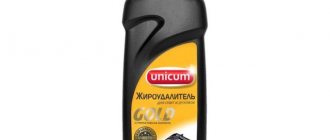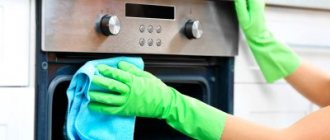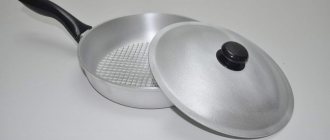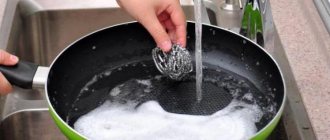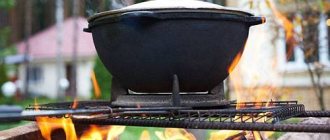Kitchen items made from aluminum alloy have a number of positive qualities. Thanks to them, they are popular with buyers. In order for a new aluminum frying pan to serve as long as possible and not lose its beautiful appearance, it must be properly prepared for use. There are various calcination techniques suitable for aluminum cookware. When performing the procedure yourself, remember the basic safety rules.
Steel frying pan
Steel cookware is completely free from corrosion if its alloy contains the correct proportion of chromium and nickel (18/10), but it still needs to be prepared for the first use, namely, by calcining the pan when it is new.
Read also: What else can you say the name Katya?
To do this, the product is thoroughly washed and dried. Vegetable (refined) oil is poured into the bottom, approximately 1 cm thick, salt is poured, and the frying pan is placed on medium heat for 15-20 minutes. As soon as the first smoke appears, the fire turns off - the calcination is completed.
The final step. The salt and oil are removed from the frying pan, and excess oil is thoroughly cleaned with a napkin. The product is not washable and in this form is ready for the first use.
Criteria for choosing a quality aluminum frying pan
Non-stick cookware for frying and stewing should be selected taking into account the following factors.
- Bottom. Its maximum thickness guarantees long service life of the frying pan. You need to pay attention to the multi-layer non-stick coating. Plasma spraying can raise the price of a product, which will serve as its additional guarantor.
- Risk when saving. Roller knurling is not the best purchase option if you want to use the product for more than a year. Aluminum cookware is not an unaffordable product. It is better to buy a more expensive frying pan so that it lasts longer.
- Prudence. You can’t skimp on quality cookware. However, when purchasing consumer goods, the risk of using a pseudo-aluminum frying pan a couple of times increases. If you have a small family budget, you should pay attention to domestic brands with excellent products at affordable prices.
The cookware is suitable for any stove: induction, electric, gas.
What can you cook?
It is inappropriate to talk about categorical prohibitions on the use of aluminum pans. But it is better not to cook individual dishes in it, which can ruin the appearance and shorten the shelf life.
Do not cook acidic or alkaline foods in aluminum pans, such as sour cabbage soup, compotes, sauces, marinades, vegetables: potatoes, beets; baby and dietary food. The acid and alkali contained in such products destroy the protective oxide layer, resulting in aluminum oxide in the form of a dark coating. Aluminum hydroxide may form, which is toxic.
You cannot collect sour berries in such a container, for example, cranberries. Since it contains a lot of acid, and it destroys the protective film, the metal comes into contact with the product and enriches it with itself. A high concentration of aluminum in berries is harmful to the body.
Aluminum pans are considered indispensable when preparing side dishes from cereals, pasta, and potatoes. These dishes do not burn and do not damage the dishes.
Is it possible to make jam?
There is no clear answer. When cooking preserves, jams, marmalade, the berries are covered with granulated sugar until the juice appears. It releases acid, which is known to destroy the protective film of an aluminum pan, and the metal comes into contact with the product. The jam is cooked in 2 or even 3 steps. It turns out that the product comes into contact with aluminum for a long time, and the jam absorbs the metal. Therefore, it is better not to use an aluminum pan for making jam. If this concerns five-minute jam, then you can cook it and immediately transfer it to jars. But, if you cook it several times, it is advisable not to use aluminum cookware.
Read also: How to spell “home”
Removing Burnt Food
The aluminum frying pan does not have a non-stick coating. Therefore, food on it may burn during cooking. You need to know what to do to quickly remove it without damaging the surface. The easiest way involves using salt. The algorithm of actions is as follows:
- Pour cold water over the burnt dishes for 10 minutes.
- Drain the water and add salt to the bottom so that it covers all areas with burnt food.
- After a few hours, remove the salt and wipe the bottom with a sponge soaked in some non-aggressive detergent.
If the described method failed to remove burnt food, then you can use another method. You need to initially prepare a solution of 15 g of laundry soap shavings, a tablespoon of ammonia and 100 ml of warm water, and then:
- Pour the mixture into the frying pan.
- Place the dishes on the fire.
- Boil for 10 minutes.
- Rinse under running water.
This method allows you to remove even heavy stains from burnt food. To restore the shine of aluminum cookware after cleaning, it is recommended to use a mixture of vinegar, mustard powder and salt. The two dry ingredients are mixed in equal proportions, and then vinegar is added until a mixture has the consistency of slurry. They clean with a sponge. Afterwards, the dishes are washed under running water.
Consolidating the effect obtained
The best way to protect an aluminum frying pan from burning for a long time is to repeat the calcination several times.
.
- wash the frying pan with soft sponges and do not use hard, abrasive or metal products;
- Stir and turn food with a wooden or plastic spatula;
- If, over time, burnt particles appear, then sprinkle them with baking soda and rub lightly - the dirt will be easily removed.
Remember that it is better to do a simple preliminary preparation before use immediately after purchasing an aluminum frying pan and not to put it off until later, when you will need it for cooking.
If you don't want to bother with preparation, buy frying pans with. Find out how to choose or in other instructions on our “Types of Cookware” website.
Manufacturers of frying pans offer us many types of frying pans: with diamond, ceramic or Teflon coating, made of aluminum, steel and other materials. But not everyone likes new cookware; many return to old frying pans and cast iron pots. And if there is no such thing left from your relatives, then you buy cast iron cookware yourself. But after purchase it is worth calcining the utensils.
Read also: Ghosts of the Tower of London
Descaling
Scale is the deposit of magnesium and calcium salts due to the use of hard water. It can be easily dealt with with acid. But, since aluminum does not like aggressive influences, we will use mild means. Here are some ways to remove scale:
- Pour one spoon of soda ash, add a glass of water, and boil. Cool. Repeat boiling 2-3 times. Usually, the scale comes off on its own. If that doesn't work, scrub a little with a sponge.
- Boil water in a container, add one tablespoon of soda and leave to cool. The scale will soften and can be easily removed with a soft cloth.
- Pour Sprite or Cola into a bowl and bring to a boil. Leave to cool, then rinse. The same can be done with cucumber pickle.
Our grandmothers used aluminum frying pans, but even today they remain a favorite utensil. They are light and comfortable. Do not require complex care. Durable. If you occasionally clean them of old stains, they will serve your grandchildren.
Calcination in a modern kitchen
In ancient times, cast iron pots were processed in stoves or over an open fire. If you do not have the opportunity to do this outdoors, then at home you can do this in several ways
. But before you begin such processing, it is worth calcining the utensils with salt.
Method No.
This method is very fast and simple. Thanks to it, you can create a new non-stick layer on the pan. The oil must be refined so that there is less burning and smoke. Can be greased with lard. This is exactly what our ancestors did.
The technique for performing such calcination is as follows:
After completing the manipulations, the utensil will remain greasy, but there is no need to wash it with detergent, since you will wash off the non-stick layer that you just created yourself. After this you will have to do the manipulations again. To keep the pan clean, wipe it dry and dry it over low heat.
Method No.
This method will allow you to fire a cauldron at home correctly. After all, it is very difficult to achieve uniform heating of high walls on a burner fire. You will have to lay the cauldron on its side, turning it over periodically. But to avoid this, you can use this technology:
Before using this option, you should open the windows wide and turn on the hood, as there will be a lot of smoke. Because of this, it is better not to fire in winter.
Method No.
Why waste precious time if you can do without long baking in the oven. But you will need a large amount of vegetable oil. It must be refined and sunflower, otherwise there will be a lot of smoke. It is better not to use olive oil.
Step-by-step calcination looks like this:
- Pour oil into a pre-prepared frying pan. It should occupy at least half the container (the ideal option is to fill the dish almost to the top with oil).
- Heat the pan with the oil over medium-low heat for 30 minutes.
- After this, wait until the container cools down and pour the oil out of it.
- Wipe the dishes dry.
Do not carry out manipulations over high heat, as the oil may burst into flames. It will be better if the fire is low and the calcination is longer. Don't leave the process uncontrolled.
Shape and size
The dimensions of the frying pan depend on its purpose. The round shape of the dishes remains traditional. If you wish, you can choose parameters with more creative lines. Functionality is important in cookware, which is worth remembering. A square-shaped aluminum frying pan will look impressive, but if you want to turn food over the fire, this format will create problems for the cook.
Aluminum in air is instantly covered with an oxide film - oxidized. As a result, aluminum products are completely rust-free.
The dimensions of the product depend on the number of people living in the family. With a diameter of 28 cm, this frying pan is ideal for cooking for all people living in the house.
Aluminum non-stick frying pan
First remove all plastic handles from the pan while processing. The most important disadvantage of aluminum cookware is the insufficient wall thickness and the lack of a non-stick coating on such cookware. The use of such frying pans leads to the fact that the bottom becomes deformed over time due to overheating and cooling, and bulges form on its flat surface. In addition, food in such pans burns. Every housewife wants to have a good, high-quality frying pan in her kitchen to prepare delicious and healthy dishes. But how to make the right choice among such a variety?
They have a thicker bottom and can be used on both gas and electric stoves. The ceramic coating is not afraid of mechanical damage - it is permissible to use non-sharp metal spatulas and spoons. It very rarely develops cracks and scratches. All such coatings are based on Teflon, they are heat-resistant, environmentally friendly, neutral to alkalis and acids.
Types of aluminum frying pans
The range of models to choose from for such products is impressive. When purchasing, it is important to evaluate three qualities of a product: practicality, price and its impact on human health.
These pans are very convenient to use, they are easy to clean and are perfect for frying any food.
Aluminum frying pan materials
Various metals are used as the basis for such utensils. However, each of them has its own characteristics. Not everyone knows the difference between cast and forged aluminum.
Cast aluminum
The weight of such a product will have more impressive parameters than its forged version. When producing this frying pan, you should expect a product with a thick bottom with high strength.
It is better to use a cast rather than stamped frying pan, because it has thicker walls and bottom, which means it can last longer.
Forged
Pressing the source material is the main technical development for such a product. Under high pressure, aluminum becomes strong. The dense and fibrous texture of the product are its main indicators.
The technology makes it possible to obtain models with thin walls and a thick bottom.
Attention! Which is better - cast or forged metal? In this case, it is difficult to choose any option. However, buyers prefer cast products.
Aluminum pan coating
When purchasing kitchenware, it is important to consider practicality and safety. The price parameters of products with a certain type of coating should also not be overlooked.
Cast cookware is suitable for any type of stove and for any type of culinary processing.
Ceramic coated
A frying pan with a ceramic inner layer meets European standards. This coating should be purchased due to its resistance to damage and high temperature. The ceramic layer does not require any time to heat up the pan. The product will last a long time and will allow you to use minimal oil when frying.
Ceramic coating is a layer of polymer composite material with silicon particles.
Disadvantages of an aluminum frying pan with a ceramic layer.
- Fragility of the material. For this reason, such utensils cannot be cleaned of dirt in the dishwasher. The exception is models with additional coating. Temperature changes are also undesirable for it due to the risk of microcracks in the ceramic coating. They are not dangerous in themselves, but they can lead to a reduction in the life of the cookware.
- High prices. Ceramics cannot be called a cheap material. As a result, an aluminum frying pan ceases to be an affordable product for every housewife.
- Restrictions on use. Hobs with an ultra-thin base are a dubious tandem with an aluminum frying pan with a ceramic coating. It is better to use it to cook food on a gas or electric stove.
A big plus is the ability to cook with a minimum amount of oil.
Non-stick frying pan
An economical option does not always imply practicality of the product. Fat scale can be removed from the non-stick layer. The metal will eventually suffer from careless care. In this case, cast aluminum is better than stamping products made from sheets of this metal.
The non-stick material is sprayed from a spray bottle and then sintered at high temperatures.
Weight and wall thickness
In itself, such dishes are not heavy utensils. Ceramic and electric stoves do not require the use of thin-walled pans. A gas heater is suitable for dishes with a thick base.
Models with a thick bottom have improved storage properties.
How an aluminum product is prepared
Aluminum equipment does not require complex preparation after purchase.
Aluminum equipment does not require complex preparation after purchase.
New aluminum frying pan - how to prepare it for use:
- Fill a new frying pan halfway with water and add lemon juice;
- Boil for 20 minutes;
- Hot steam has a detrimental effect on microorganisms, and lemon helps eliminate unpleasant odors that come from a new product.
You can also use coarse salt for calcination. After rinsing the pan, pour salt into it. The heating process is carried out for 20 minutes over low heat. After this, turn off the stove and leave the salt until it cools completely, then throw it away. Finish the treatment by wiping with a cloth soaked in oil.
Sometimes there may be an unpleasant odor when heating, but this is normal.
How to clean old grease
Besides the fact that it is not aesthetically pleasing, it is also dangerous to cook in a frying pan with old fat, because you can get poisoned. You can clean such stains at home using laundry soap. Cleaning sequence:
- grate the soap;
- sprinkle it on the pan;
- pour hot water and let stand.
- If the contamination is old, it is better to boil it in a basin.
While boiling with soap, the pan should be immersed in water.
Another solution in the fight against old fat from an aluminum frying pan is ammonia. Soak a soft cloth with it and wipe the dishes. By mixing ammonia with hot water, you can wash it after soaking it for a couple of hours.
Important! This cleaning should only be done in a well-ventilated area, or even better, outside.
Methods for calcining an aluminum frying pan
The methods were invented and used by people a long time ago, when there were no non-stick coatings. The purpose of the procedure for preparing for the first use is to clog the pores and create a kind of protective film. The fact is that aluminum has micropores, which is why burning occurs. Calcination helps fill them until the moment the cooked food sticks to the bottom.
“Grandma’s” method using salt
The most common and simplest option for preparing for first use:
- Place a clean, dry frying pan on the stove and turn the heat as low as possible.
- Cover the bottom with coarse table salt in a layer of approximately 1 cm.
- Reheat for 20 minutes, then let cool completely.
- Remove the salt from the bottom and wipe with a soft cloth soaked in refined vegetable oil.
- Use after 2-3 days.
Option with water without salt
Boil water in a frying pan, then drain. Leave to dry naturally without wiping. Apply vegetable oil evenly to the surface and do not use treated aluminum cookware for several days.
Calcination with vegetable oil
An equally common method for preparing a new aluminum frying pan for use is as follows:
- Pour in enough vegetable oil to completely cover the bottom.
- Heat it over low heat for an average of 20-25 minutes.
- After cooling, rinse with clean water without using chemicals.
- Use the dishes after a while (1-2 days).
Before work, set the hood to maximum mode, open the windows, as a characteristic smell will appear during heating. Be sure to use refined oil, otherwise there will be a lot of smoke.
Combined method
This method combines the two previous ones, which use oil and salt. A good effect is obtained if you take two ingredients at the same time. To do this, when you start heating the oil, add a tablespoon of salt to it. After 20 minutes, stop heating, let cool, rinse.
Can I use a dishwasher to wash pans?
Before loading the pan into the dishwasher, you must read the instructions for its use. It indicates what materials the dishes can be washed in. Also on the products themselves there are symbols that tell you how to wash the dish.
Do not place cast iron, aluminum or Teflon pans in the dishwasher.
Do not place cast iron, aluminum or Teflon pans in the dishwasher. After such manipulation, the food in them will begin to burn, and the product may lose its shape.
- Cast iron objects have an uneven surface. Before each use, it is advisable to calcinate to fill the pores. It fills unevenness and creates a protective film. Under the influence of detergents or too hard sponges, the protective layer is washed off. This leads to the formation of rust on the surface, and food begins to stick to the bottom during cooking. Cast iron frying pans are subject to gels and abrasive powders in the dishwasher. Staying in water for too long will damage the dishes.
- The Teflon coating is also vulnerable to washing in the dishwasher. The polymer surface is easily damaged by mechanical stress. Manufacturers recommend stirring food with a wooden spatula during cooking. When washing in the car, the film may peel off. Teflon has non-stick characteristics, so washing it by hand is not difficult.
- Aluminum cookware is known for being cheap and ineffective. This equipment heats up quickly, which leads to food sticking.
These dishes cannot be washed in a machine. Pans quickly darken and release toxic substances that negatively affect human health. Food prepared in such containers is not suitable for consumption.
In the dishwasher, the oxide film is quickly destroyed. This is caused by too much water pressure and alkaline cleaning fluids. Metal reacts to water, which leads to its darkening and destruction. Darkening may not occur at once, but with each wash, the destruction of the surface will become more pronounced.
It is important to properly prepare the frying pan for use, then the kitchen equipment will serve for many years.
Heating a frying pan is an important condition for long-term operation. Therefore, you need to carry out this process correctly, then the kitchen equipment will serve for many years.
Important safety rules when calcining an aluminum frying pan
To avoid injury and burns, carefully follow the safety rules during calcination:
- Remove the product from the heat using thick oven mitts or oven mittens. Then place it on a special stand, and not on the table surface.
- Do not add water to heated oil.
- Do not wash a hot pan. Give it time to cool a little and only then start cleaning.
- Remove flammable objects from the stove.
- Turn on the hood to maximum mode and open the window.
- Do not exceed the incandescent temperature allowed in the instructions.
How to restore the shine of metal?
Vinegar, like a soap solution, is applied to chrome surfaces using a soft cloth or household spray. This substance begins to act immediately after application - the plaque literally dissolves before our eyes and all that remains is to wash it off from the item being cleaned with warm water.
Interesting materials:
How to open the Samsung remote? How to open Zanussi? How to break off a ficus? How to clean a cutting board? How to clean a shower stall in hard-to-reach places? How to clean a bathroom stall? How to clean brick on a balcony? How to wash a plastic diesel fuel barrel? How to clean a shower hose? How to polish a granite countertop?
Preparing for calcination
There are several ways to heat cast iron cookware, but before any of them, the frying pan or cauldron must be prepared. To do this, completely remove the original packaging and wash the dishes with a mild detergent or soap solution. It is better to avoid hard sponges so as not to damage the coating.
After this, the dishes must be wiped dry. If you choose the option of baking in the oven, you must remove the handle.
If the handle is made of plastic or wood and cannot be removed, then only the method of hardening the pan on the stove will do. The stove can be any - gas, electric or induction.
A frying pan burns - what to do: 7 tips and 3 methods
When out of three frying pans in our kitchen, only one was left in good condition, I decided to figure out whether it was possible to restore the dishes. I read expert advice on what to do to prevent it from sticking to the pan, and studied the manufacturers' recommendations. I'll tell you how to give a second life to products.
If you wash a non-stick product or a cast iron frying pan with a metal sponge, don’t be surprised that food sticks to the surface
In what other cases is it necessary to calcinate
Calcination is required not only for a new frying pan, but also for the sake of prevention and even getting rid of problems that have appeared on old ones.
- Cast iron frying pans often form carbon deposits - burnt oil. This is harmful to health, so you should not cook on such a surface. In this case, calcination will help, since it can destroy the accumulated carbon deposits, after which it will be easy to wash. Usually the question of how to properly burn a frying pan from soot is asked before cooking pancakes. This way the pan is cleared of old oil - even the first pancake will not be lumpy.
- If cast iron cookware begins to rust, then it must be properly treated to remove rust. First of all, it is necessary to clean the damaged areas. This can be done with a special product or a simple cleaning powder. After this, they are additionally sanded with fine-grain sandpaper. The cookware can then be baked to create a new protective coating to prevent future rust.
Why is this necessary?
Cast iron pans are considered the safest for cooking. Many types of dishes are baked, fried and stewed on such a surface, and they turn out better than on other types of frying pans. If you use cast iron correctly, it will last for many years.
Before you try the frying pan in action, it is not enough to simply wash it with the product. It is necessary to carry out a calcination procedure. Why is it recommended to heat a cast iron frying pan before cooking? Main reasons:
- Before sending dishes to the market, manufacturers coat them with oil lubricants to reduce the harmful effects of the environment, protect them from the ubiquitous rust and give them a marketable appearance. Calcination rids the surface of traces of production that are unsafe when cooking. These oils can emit a pungent odor when evaporating.
- Cast iron is a porous material, although this is not visible to the naked eye. To prevent pieces of food from clogging pores and emitting an unpleasant odor during cooking, calcination should be carried out. It will cover the surface with a protective film and extend the life of the product, and will also have a positive effect on the taste of the products.
- After calcination, the food will not constantly burn. Cleaning the pan will be much easier and faster.
- The measure protects cast iron pans from corrosion.
- In this way you can check the strength of the purchased frying pan. If during the calcination process it cracks and becomes covered with bubbles, then the material is clearly not of the best quality, you should not regret it and there is a reason to write a complaint to the seller.
The point of baking a new frying pan is to seal the pores. For the procedure you will need salt, oil and an oven. Regardless of the method chosen, the dishes require preparation: wash them with warm water and a soft sponge, then wipe dry with paper or kitchen towels.
How to properly prepare pans from different materials
Calcination methods are different and suitable for different types of coating. It is important to remember that you must prepare the pan according to the type of pan.
Before you start heating the frying pan, you will need to prepare for use, namely, first clean it.
Cast-iron pan
A good cast iron frying pan is a godsend for a cook. Advantages of a cast iron frying pan:
- allows long-term processing of products even over high heat;
- you can use iron spatulas for stirring and wash with hard washcloths;
- if properly calcined, the frying pan will be equipped with good non-stick properties;
- can be washed even with coarse abrasives;
- in models with a removable handle, you can bake food in the oven;
- long, almost unlimited service life.

